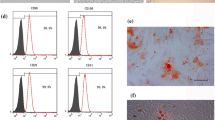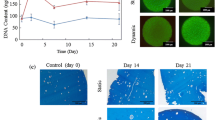Abstract
While the potential for intermittent hydrostatic pressure to promote cartilaginous matrix synthesis is well established, its potential to influence chondroinduction remains poorly understood. This study examined the effects of relatively short- and long-duration cyclic hydrostatic compression on the chondroinduction of C3H/10T1/2 murine embryonic fibroblasts by recombinant human bone morphogenetic protein-2 (rhBMP-2). Cells were seeded at high density into round bottom wells of a 96-well plate and supplemented with 25 ng/ml rhBMP-2. Experimental cultures were subjected to either 1,800 cycles/day or 7,200 cycles/day of 1 Hz sinusoidal hydrostatic compression to 5 MPa (applied 10 min on/10 min off) for 3 days. Non-pressurized control and experimental cultures were maintained in static culture for an additional 5 days. Cultures were then analyzed for alcian blue staining intensity, DNA and sulfated glycosaminoglycan (sGAG) content, and for the rate of collagen synthesis. Whereas cultures subjected to 1,800 pressure cycles exhibited no significant differences (statistical or qualitative) compared to controls, those subjected to 7,200 cycles stained more intensely with alcian blue, contained nearly twice as much sGAG, and displayed twice the rate of collagen synthesis as non-pressurized controls. This study demonstrates the potential for cyclic hydrostatic compression to stimulate chondrogenic differentiation of the C3H/10T1/2 cell line in a duration-dependent manner.




Similar content being viewed by others
References
Angele P, Yoo JU, Smith C, Mansour J, Jepsen KJ, Nerlich M, Johnstone B (2003) Cyclic hydrostatic pressure enhances the chondrogenic phenotype of human mesenchymal progenitor cells differentiated in vitro. J Orthop Res 21(3):451–457
Ashhurst DE (1986) The influence of mechanical conditions on the healing of experimental fractures in the rabbit: a microscopical study. Philos Trans R Soc Lond B Biol Sci 313(1161):271–302
Atkinson BL, Fantle KS, Benedict JJ, Huffer WE, Gutierrez-Hartmann A (1997) Combination of osteoinductive bone proteins differentiates mesenchymal C3H/10T1/2 cells specifically to the cartilage lineage. J Cell Biochem. 65(3):325–339
Bachner D, Schroder D, Betat N, Ahrens M, Gross G (1999) Apolipoprotein E (ApoE), a Bmp-2 (bone morphogenetic protein) upregulated gene in mesenchymal progenitors (C3H10T1/2), is highly expressed in murine embryonic development. Biofactors 9(1):11–17
Bachrach NM, Valhmu WB, Stazzone E, Ratcliffe A, Lai WM, Mow VC (1995) Changes in proteoglycan synthesis of chondrocytes in articular cartilage are associated with the time-dependent changes in their mechanical environment. J Biomech 28(12):1561–1569
Bartsch JW, Jackel M, Perz A, Jockusch H. (2000) Steroid RU 486 inducible myogenesis by 10T1/2 fibroblastic mouse cells. FEBS Lett 467(1):123–127
Bassett CAL, Herrmann I (1961) Influence of oxygen concentration and mechanical factors on differentiation of connective tissue in vitro. Nature 190(4774):460–461
Carter DR, Orr TE, Fyhrie DP, Schurman DJ (1987) Influences of mechanical stress on prenatal and postnatal skeletal development. Clin Orthop 219:237–250
Carter DR, Blenman PR, Beaupre GS (1988) Correlations between mechanical stress history and tissue differentiation in initial fracture healing. J Orthop Res 6(5):736–748
Carver SE, Heath CA (1999a) Increasing extracellular matrix production in regenerating cartilage with intermittent physiological pressure. Biotechnol Bioeng 62(2):166–174
Carver SE, Heath CA (1999b) Semi-continuous perfusion system for delivering intermittent physiological pressure to regenerating cartilage. Tissue Eng 5(1):1–11
Chen TL, Shen WJ, Kraemer FB (2001) Human BMP-7/OP-1 induces the growth and differentiation of adipocytes and osteoblasts in bone marrow stromal cell cultures. J Cell Biochem 82(2):187–199
D’Andrea P, Calabrese A, Capozzi I, Grandolfo M, Tonon R, Vittur F (2000) Intercellular Ca2+ waves in mechanically stimulated articular chondrocytes. Biorheology 37(1–2):75–83
Denker AE, Haas AR, Nicoll SB, Tuan RS (1999) Chondrogenic differentiation of murine C3H10T1/2 multipotential mesenchymal cells: I. Stimulation by bone morphogenetic protein-2 in high-density micromass cultures. Differentiation 64(2):67–76
Elder SH, Kimura JH, Soslowsky LJ, Lavagnino M, Goldstein SA (2000) Effect of compressive loading on chondrocyte differentiation in agarose cultures of chick limb-bud cells. J Orthop Res 18(1):78–86
Ellison BE, Carter DR, Smith RL (1994) Effect of variable duration intermittent hydrostatic pressure on cartilage glycoaminoglycan synthesis. Trans Orthop Res Soc 19:486
Hall AC, Urban JPG, Gehl KA (1991) The effects of hydrostatic pressure on matrix synthesis in articular cartilage. J Orthop Res 9:1–10
Hollnagel A, Ahrens M, Gross G (1997) Parathyroid hormone enhances early and suppresses late stages of osteogenic and chondrogenic development in a BMP-dependent mesenchymal differentiation system (C3H10T1/2). J Bone Miner Res 12(12):1993–2004
Ikenoue T, Trindade MC, Lee MS, Lin EY, Schurman DJ, Goodman SB, Smith RL (2003) Mechanoregulation of human articular chondrocyte aggrecan and type II collagen expression by intermittent hydrostatic pressure in vitro. J Orthop Res 21(1):110–116
Yusuhiko K, Hugo H, Juergen M (1997) Analysis of 3H-Proline-labeled protein by rapid filtration in multiwell plates for the study of collagen metabolism. Biotechniques 22:706–716
Mauck RL, Oswald ES, Cheng Q, Majumdar MK, Nicoll SB, Ateshian GA, Hung CT (2003) Hydrostatic pressure enhances chondrogenic differentiation of human multipotential mesenchymal cells in alginate disks. In: Trans ASME summer bioengineering conference, pp 265–266
Mow VC, Ratcliffe A, Poole AR (1992) Cartilage and diarthrodial joints as paradigms for hierarchical materials and structures. Biomaterials 13(2):67–97
Nagatomi J, Arulanandam BP, Metzger DW, Meunier A, Bizios R (2001) Frequency- and duration-dependent effects of cyclic pressure on select bone cell functions. Tissue Eng 7(6):717–728
Page M, Ashhurst DE (1987) The effects of mechanical stability on the macromolecules of the connective tissue matrices produced during fracture healing. II. The glycosaminoglycans. Histochem J 19(1):39–61
Page M, Hogg J, Ashhurst DE (1986) The effects of mechanical stability on the macromolecules of the connective tissue matrices produced during fracture healing. I. The collagens. Histochem J 18(5):251–265
Parkkinen JJ, Ikonen J, Lammi MJ, Laakkonen J, Tammi M, Helminen HJ (1993) Effects of cyclic hydrostatic pressure on proteoglycan synthesis in cultured chondrocytes and articular cartilage explants. Arch Biochem Biophys 300(1):458–465
Pauwels F (1980) A new theory concerning the influence of mechanical stimuli on the differentiation of the supporting tissues. In: Biomechanics of the locomotor apparatus: contributions on the functional anatomy of the locomotor apparatus. Springer, Berlin Heidelberg New York, pp 375–407
Seghatoleslami MR, Roman-Blas JA, Rainville AM, Modaressi R, Danielson KG, Tuan RS (2003) Progression of chondrogenesis in C3H10T1/2 cells is associated with prolonged and tight regulation of ERK1/2. J Cell Biochem 88(6):1129–1144
Singh R, Artaza JN, Taylor WE, Gonzalez-Cadavid NF, Bhasin S (2003) Androgens stimulate myogenic differentiation and inhibit adipogenesis in C3H 10T1/2 pluripotent cells through an androgen receptor-mediated pathway. Endocrinology 144(11):5081–5088
Smith RL, Lin J, Trindade MC, Shida J, Kajiyama G, Vu T, Hoffman AR, van der Meulen MC, Goodman SB, Schurman DJ, Carter DR (2000) Time-dependent effects of intermittent hydrostatic pressure on articular chondrocyte type II collagen and aggrecan mRNA expression. J Rehabil Res Dev 37(2):153–161
Spinella-Jaegle S, Rawadi G, Kawai S, Gallea S, Faucheu C, Mollat P, Courtois B, Bergaud B, Ramez V, Blanchet AM, Adelmant G, Baron R, Roman-Roman S (2001) Sonic hedgehog increases the commitment of pluripotent mesenchymal cells into the osteoblastic lineage and abolishes adipocytic differentiation. J Cell Sci 114(Pt 11):2085–2094
Takahashi I, Nuckolls GH, Takahashi K, Tanaka O, Semba I, Dashner R, Shum L, Slavkin HC (1998) Compressive force promotes sox9, type II collagen and aggrecan and inhibits IL-1beta expression resulting in chondrogenesis in mouse embryonic limb bud mesenchymal cells. J Cell Sci 111(Pt 14):2067–2076
Tang QQ, Otto TC, Lane MD (2004) Commitment of C3H10T1/2 pluripotent stem cells to the adipocyte lineage. Proc Natl Acad Sci USA 101(26):9607–9611
Taylor SM, Jones PA (1979) Multiple new phenotypes induced in 10T1/2 and 3T3 cells treated with 5-azacytidine. Cell 17(4):771–779
Toyoda T, Seedhom BB, Kirkham J, Bonass WA. (2003) Upregulation of aggrecan and type II collagen mRNA expression in bovine chondrocytes by the application of hydrostatic pressure. Biorheology 40(1–3):79–85
Wong M, Siegrist M, Goodwin K, Park Y (2002) Hydrostatic pressure, tension and unconfined compression differentially regulate expression of cartilage matrix proteins. Trans Orthop Res Soc 27:33
Acknowledgements
This research was supported by a Whitaker Foundation Biomedical Engineering Research Grant (RG-00-0371) and the Department of Agricultural & Biological Engineering, Mississippi State University. rhBMP-2 was a generous gift of Wyeth Pharmaceuticals, Cambridge, MA. The authors would also like to thank Dr. Randal Buddington, Professor of Biological Sciences at Mississippi State University, for his technical assistance.
Author information
Authors and Affiliations
Corresponding author
Rights and permissions
About this article
Cite this article
Elder, S., Fulzele, K. & McCulley, W. Cyclic hydrostatic compression stimulates chondroinduction of C3H/10T1/2 cells. Biomech Model Mechanobiol 3, 141–146 (2005). https://doi.org/10.1007/s10237-004-0058-3
Received:
Accepted:
Published:
Issue Date:
DOI: https://doi.org/10.1007/s10237-004-0058-3




